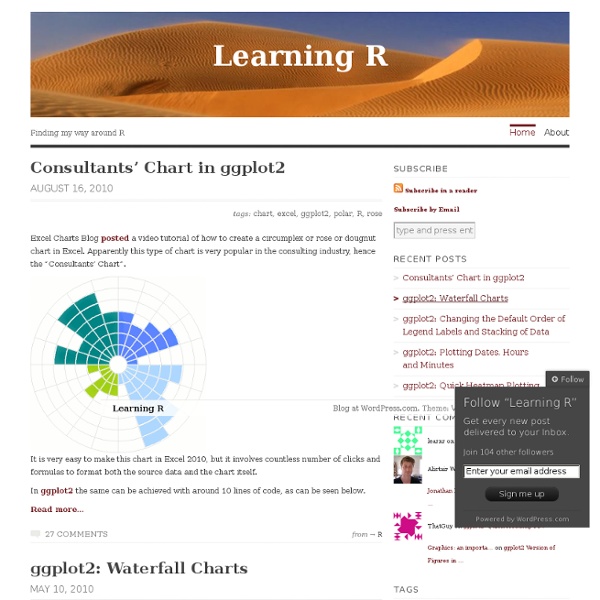



Graphs - R Cookbook My book about data visualization in R is available! The book covers many of the same topics as the Graphs and Data Manipulation sections of this website, but it goes into more depth and covers a broader range of techniques. You can preview it at Google Books. Purchase it from Amazon, or direct from O'Reilly. There are many ways of making graphs in R, each with its advantages and disadvantages. Graphs with ggplot2 Miscellaneous Output to a file - PDF, PNG, TIFF, SVG Shapes and line types - Set the shape of points and patterns used in lines. Basic graphs with standard graphics Other interesting graphs Correlation matrix ggplot2 online documentation Summer 2010 — R: ggplot2 Intro Contents Intro When it comes to producing graphics in R, there are basically three options for your average user. base graphics I've written up a pretty comprehensive description for use of base graphics here, and don't intend to extend beyond that. Both and make creating plots of multivariate data easier. The website for ggplot2 is here: Basics is meant to be an implementation of the Grammar of Graphics, hence gg-plot. Plots convey information through various aspects of their aesthetics. x position y position size of elements shape of elements color of elements The elements in a plot are geometric shapes, like points lines line segments bars text Some of these geometries have their own particular aesthetics. points point shape point size lines line type line weight bars y minimum y maximum fill color outline color text label value The values represented in the plot are the product of various statistics. Layer by Layer Displaying Statistics
R by example Basics Reading files Graphs Probability and statistics Regression Time-series analysis All these examples in one tarfile. Outright non-working code is unlikely, though occasionally my fingers fumble or code-rot occurs. Other useful materials Suggestions for learning R The R project is at : In particular, see the `other docs' there. Over and above the strong set of functions that you get in `off the shelf' R, there is a concept like CPAN (of the perl world) or CTAN (of the tex world), where there is a large, well-organised collection of 3rd party software, written by people all over the world. The dynamism of R and of the surrounding 3rd party packages has thrown up the need for a newsletter, R News. library(help=boot) library(boot) ? But you will learn a lot more by reading the article Resampling Methods in R: The boot package by Angelo J. Ajay Shah, 2005
book R Reference Card Software Resources for R Software Resources for R Below is a list of resource pages for using R to do statistics. On each page a set of data are explored with the software. Some commentary is given on interpretation but the main focus is on getting the software to do the work. Getting Started Entering data Simple summary statistics Stem and leaf plots Histograms Boxplots Dotplots Logarithmic transformations Saving your data Summarizing Quantitative Data Simple summary statistics Boxplots comparing two groups Transformations Summarizing a Single Categorical Variable Mode Tables Bar charts Pie charts Making and Interpreting Tables for Two Categorical Variables One- and Two-Way Tables Probability and two-way tables Inference for One Proportion Confidence interval Hypothesis test Inference for Two Proportions Chi-Squared Tests One-way (Goodness of Fit) Two-way (Contingency Tables) Inference for a Single Mean Inference for Two Means (Independent Samples) Inference for Paired Differences Scatterplots and Correlation
The R Project for Statistical Computing developers:projects:gsoc2012:ropensci Summary: Dynamic access and visualization of scientific data repositories Description: rOpenSci is a collaborative effort to develop R-based tools for facilitating Open Science. Projects in rOpenSci fall into two categories: those for working with the scientific literature, and those for working directly with the databases. See a complete list of our R packages currently in development. The student could choose to work on a package for a particular data repository of interest, or develop tools for visualization and exploration that could function across the existing packages. Skills required: Should be able to use R to perform data manipulation and aggregation. Mentor: The rOpenSci dev team, Carl Boettiger, Scott Chamberlain, and Karthik Ram, with support from rOpenSci advisors Hadley Wickam, Duncan Temple Lang, Bertram Ludascher, JJ Allaire and Matt Jones.
start [R Wiki] * R is a free software environment for statistical computing and graphics. It runs on a wide variety of UNIX platforms, Windows and MacOS. This R Wiki is dedicated to the collaborative writing of R documentation. For information on browsers, RSS syndication, copyright, ... read usage. R comes with several official manuals and FAQs. Personal note: I have some difficulties with the statement that the official manuals should be your primary source of information. Books I found ordinary books to be the most helpful source of information for novice programmers and I can particularly recommend: Adler, J. (2010) R in a nutshell. Help forum for programmers The R-Help mailing list can give excellent answers, but due to the high calibre of respondents it can be intimidating, (and off-putting). In addition I can’t but feel that many questions are a waste of time for most of those who respond. Stackoverflow Table of contents (click on an item to expand) Guides